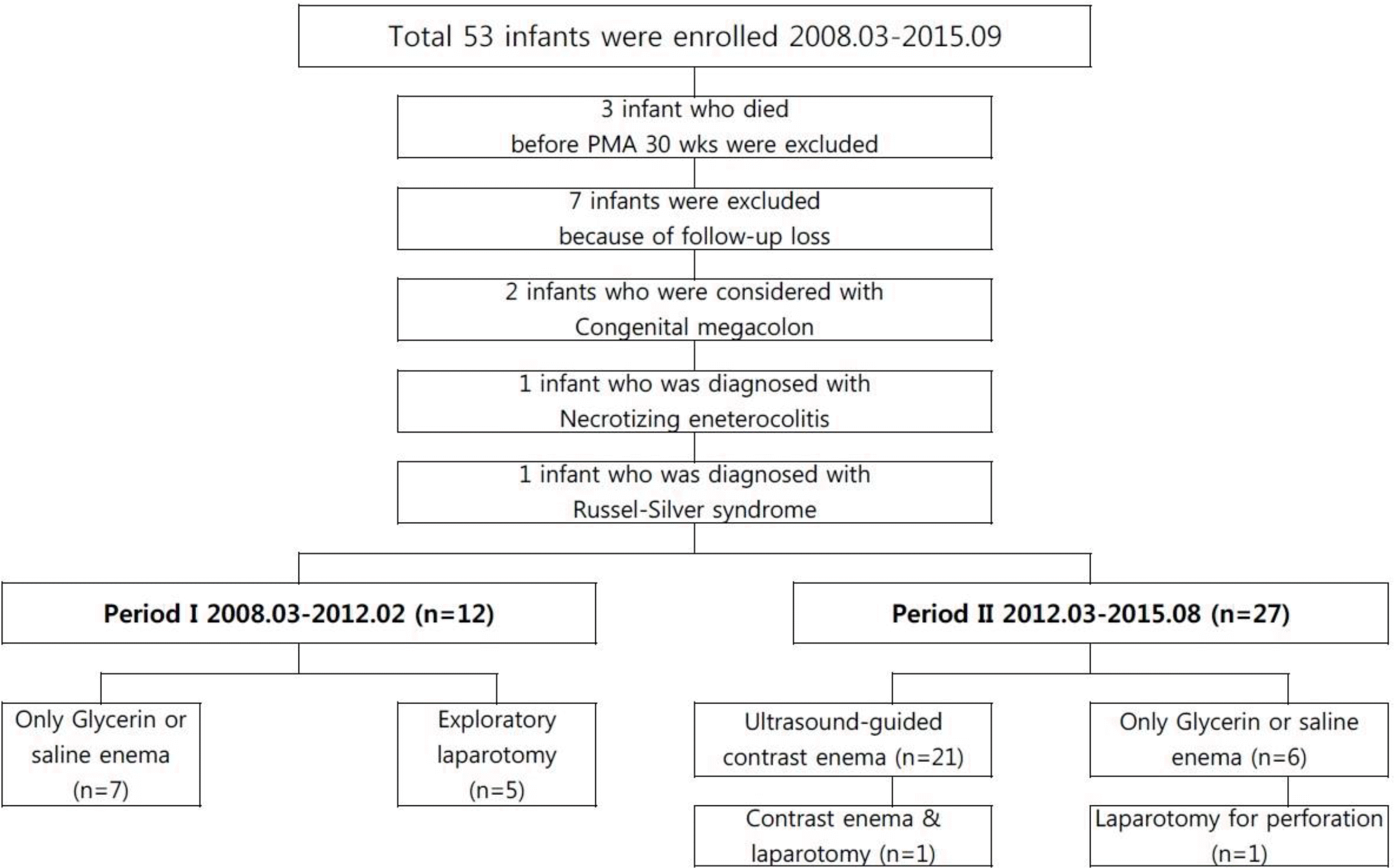Abstract
Purpose:
This study aims to compare the effectiveness and safety of ultrasound-guided contrast enema comparing with exploratory laparotomy for meconium plug syndrome in preterm infants.
Methods:
Fifty-three preterm infants who were diagnosed with meconium plug syndrome among the neonates admitted to the Neonatal Intensive Care Unit of the Seoul National University Bundang Hospital from March 2008 to August 2015 were analyzed retrospectively. Four-teen infants among the 53 infants were excluded and Thirty-nine infants were analyzed. That time were divided into Period I and Period II. There was no pediatric radiologist and we couldn’t try contrast enema in Period I. Pediatric radiologist was appointed and ultrasound guided contrast enema has been available in Period II.
Result:
There were no specific differences of demographic characters between both Periods. Invasive procedure including contrast enema was increased in Period II than Period I (81% vs. 42%; P<0.05) and there were more exploratory laparotomy in Period I than in Period II (42% vs. 7%; P<0.05). Complications after treatment of meconium plug syndrome were more frequent in exploratory laparotomy groups than in ultrasound-guided contrast enema (57% vs. 0%; P<0.05) and total parenteral nutrition days were longer in laparotomy groups than in contrast enema groups (61±30 days vs. 31±13 days; P<0.05).
Go to : 
REFERENCES
1). Haram-Mourabet S., Harper R G., Wapnir RA. Mineral composition of meconium: effect of prematurity. J Am Coll Nutr. 1988. 17:356–60.
2). Weaver LT., Lucas A. Development of bowel habit in preterm infants. Arch Dis Child. 1993. 68:317–20.

3). Emil S., Nguyen T., Sills J., Padilla G. Meconium obstruction in extremely low birth-weight neonates: guidelines for diagnosis and management. J Pediatr Surg. 2004. 39:731–7.
4). Dimmitt RA., Moss RL. Meconium diseases in infants with very low birth weight. Semin Pediatr Surg. 2000. 9:79–83.

5). Loening-Baucke V., Kimura K. Failure to pass meconium: diagnosing neonatal intestinal obstruction. Am Fam Physician. 1999. 60:2043–50.
6). Burke MS., Ragi JM., Karamanoukian HL., Kotter M., Brisseau GF., Borowitz DS, et al. New strategies in nonoperative management of meconium ileus. J Pediatr Surg. 2002. 37:760–4.

7). Hong KB., Seong IC., Lee KS., Chang YP., Song HS. Meconium Obstruction in Very Low Birth Weight Infants. Korean J Pediatr Gastroenterol Nutr. 2011. 14:52–8.

8). Lubchenco LO., Hansman C., Dressler M., Boyd E. Intrauterine growth as estimated from liveborn birth-weight data at 24 to 42 weeks of gestation. Pediatrics. 1963. 32:793–800.

10). Bell MJ., Ternberg JL., Feigin RD., Keating JP., Marshall R., Barton L, et al. Neonatal necrotizing enterocolitis. Therapeutic decisions based upon clinical staging. Ann Surg. 1978. 187:1–7.
11). Clatworthy HW., Howard WH., Lloyd J. The meconium plug syndrome. Surgery. 1956. 39:131–42.
12). Yoo SY., Jung SH., Eom M., Kim IH., Han A. Delayed maturation of interstitial cells of Cajal in meconium obstruction. J Pediatr Surg. 2002. 37:1758–61.

13). Greenholz SK., Perez C., Wesley JR., Marr CC. Meconium obstruction in the markedly premature infant. J Pediatr Surg. 1996. 31:117–20.

14). Sokal MM., Koenigsberger MR., Rose JS., Berdon WE., Santuli TV. Neonatal hypermagnesemia and the meconium-plug syndrome. N Engl J Med. 1972. 286:823–5.

15). Hutchinson HT., Nichols MM., Kuhn CR., Vasicka A. Effects of magnesium sulfate on uterine contraction, intrauterine fetus and infant. Am J Obstet Gyneco. 1964. 88:747–58.
16). Yi GC., Kang KJ., Kim EH., Kim CS., Lee SL. Clinical features and Outcomes of Meconium Intestinal Obstruction in Preterm Infants. Korean J Perinatol. 2012. 23:242–9.
17). Fenton TR., Lyon AW., Rose MS. Cord blood calcium, phosphate, magnesium, and alkaline phosphatase gestational age-specific reference intervals for preterm infants. BMC Pediatr. 2011. 11:76.

18). Stewart DR., Nixon GW., Johnson DG., Condon VR. Neonatal small left colon syndrome. Ann Surg. 1977. 186:741–5.

19). Philippart AI., Reed JO., Georgeson KE. Neonatal small left colon syndrome: intramural not intraluminal obstruction. J Pediatr Surg. 1975. 10:733–40.

20). Mihatsch WA., Franz AR., Lindner W., Pohlandt F. Meconium passage in extremely low birthweight infants and its relation to very early enteral nutrition. Acta Paediatr. 2001. 90:409–11.

21). Flidel-Rimon O., Friedman S., Lev E., Juster-Reicher A., Amitay M., Shinwell ES. Early enteral feeding and nosocomial sepsis in very low birthweight infants. Arch Dis Child Fetal Neonatal Ed. 2004. 89:F289–92.

22). Shim SY., Kim HS., Kim DH., Kim EK., Son DW., Kim BI, et al. Induction of early meconium evacuation promotes feeding tolerance in very low birth weight infants. Neonatology. 2007. 92:67–72.

23). Noblett HR. Treatment of uncomplicated meconium ileus by Gastrografin enema: a preliminary report. J Pediatr Surg. 1969. 4:190–7.

24). Shaw A. Safety of N-acetylcystein in treatment of meconium obstruction of the newborn. J Pediatr Surg. 1969. 4:119–25.
Go to : 
Table 1.
Characters of Demographics between Period I and Period II
Table 2.
Comparison of Clinical Outcomes between Period I and Period II
Table 3.
Comparison of Clinical Characters between Contrast Enema Groups and Exploratory Laparotomy Groups




 PDF
PDF ePub
ePub Citation
Citation Print
Print



 XML Download
XML Download